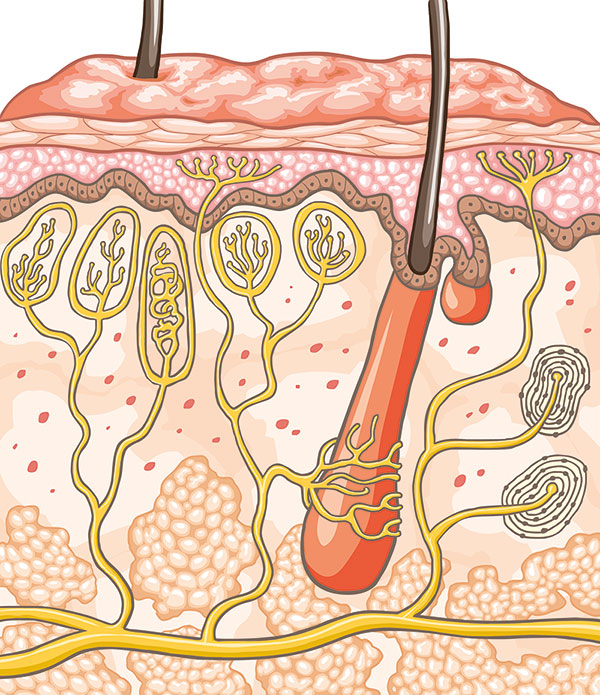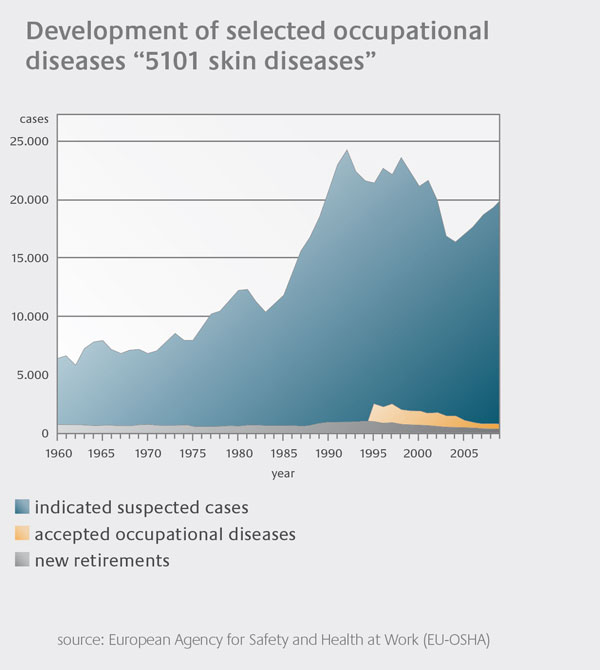Occupational Skin Diseases
The skin forms the barrier between a human being and his or her environment. It protects the body from harmful effects, but is exposed to these influences itself at the same time. Especially in occupational life, the skin has to resist high strains. If the skin is not sufficiently protected, skin diseases may occur.
A third of all confirmed occupational diseases in Germany affect the skin. In 2010 alone, over 23,500 new cases of dermatitis occurred. Experts assume that the actual number might be 50 to 100 times higher.

Functions of the Skin
With a surface of about two square meters, the skin is the biggest human organ. It is not only the body’s outer cover, but also carries out a multitude of important tasks. As a barrier, it protects the body from mechanical, chemical and thermal influences, softens the harmful effects of sunlight and wards off microorganisms. The skin regulates the body-heat balance and serves as storage of greases, carbohydrates, water and salts. Basic metabolic processes take place inside the skin. Most importantly, the skin forms the outer appearance of a human being and therefore, it is very important for social life and self-perception.
The Pathogenesis of Dermatitis at Workplace
90 percent of all occupational skin diseases are irritant and allergic eczema caused by the direct contact with hazardous substances. These substances are often only slightly skin irritating, but over time, the delayed effects from repetitive irritation may cumulatively damage the skin. The outer layer of the skin is the horny layer, which serves as a barrier against chemical and physical influences. Water and fatdissolving materials like tensides and organic solvents loosen the building blocks of the horny layer and undermine its barrier function. Due to these damages, the skin increasingly loses water, dries out and becomes rough and chapped. Moreover, hazardous substances and potential allergens can be absorbed more easily into the skin and may cause further damage.
A healthy horny layer continuously regenerates; the dead epithelial cells of the horny layer are always being replaced. However, repeated irritation also attacks and damages the skin’s ability to heal itself. This may result in chronic skin disease.
Dermatitis – The Most Frequent Occupational Disease
Occupational skin diseases are by far the most frequent health risk at work. More than 25 percent of all occupational diseases are skin related. Between the ages of 15 and 25, the percentages even rise as high as 90 percent. Many occupational dermatitis issues run a chronic course, especially if they are not recognized and treated in time.
It is estimated that up to 5 billion euros are lost annually in European industries due to a loss of productivity caused by occupational skin diseases. Small and mediumsized companies, where industrial safety and occupationalmedical care are not always available, are impacted the most.
Consequences for Affected Persons and Society
Loss of manpower, retraining, disability and medical costs – occupational skin diseases result in higher costs for the economy and the healthcare system. But above all, they are a high personal stress factor for the affected persons, who often are no longer able to pursue their profession. Quite often, loss of social status is the result. In addition to the occupational difficulties, affected persons suffer from considerable restrictions in their everyday life. Serious skin diseases reduce quality of life as severely as the consequences of a cardiac infarction or an apoplectic stroke. Furthermore, the disfiguring effect of many dermatitis cases may have a negative psychological impact resulting in withdrawal from society and depression.

Skin Protection and Prevention: A Legal Obligation for Every Employer
The German Occupational Safety and Health Act obliges employers to take appropriate measures against work-related health risks. According to the European PPE User Directive, occupational skin protection agents are regarded as a part of the personal protective equipment (PPE). In case of an imminent occupational disease, the costs for skin protection agents can be borne by accident insurance if requested by a physician.
The relevant directive “TRGS 401 – Risks resulting from skin contact” defines occupational skin protection agents as products that are used within the scope of an integrated concept in order to prevent occupational skin diseases and that have been proven and confirmed in terms of efficacy and skin-compatibility. In addition to skin protection agents, skin cleansing and skin care products are also part of an integrated concept.

